🎗️Lonny's War Update- October 736, 2023 - October 11, 2025 🎗️
🎗️Day 736 that 48 of our hostages are still in Hamas captivity🎗️
A very important interview with Dr.Gershon Baskin, the initiator and architect of the Trump Proposal, about how the Trump deal came about and what we can look towards going forward:
WATCH: Israeli Hostage Negotiator Reacts to Ceasefire and Hostage Release Deal
Gaza ceasefire starts as IDF completes partial withdrawal; Hamas has 72 hours to return hostages
Soldier killed by Hamas sniper hours before deal goes into effect; IDF, Hamas warn Gazans not to approach troops in new positions; coastal road opens for Palestinians to return to Gaza City
The Israel Defense Forces completed a withdrawal to agreed-upon deployment lines in the Gaza Strip on Friday at noon, officially beginning a ceasefire and a 72-hour countdown during which Hamas is to release the 48 hostages it is holding under the first phase of the US-brokered deal.
The withdrawal was conducted under the cover of artillery shelling and airstrikes in some areas, and an IDF reservist was killed by a Hamas sniper hours before the agreement went into place.
The completion of the withdrawal started a 72-hour countdown, during which Hamas is obligated to release all the living hostages and as many of the dead hostages that it can secure, according to the terms of the deal. That puts the deadline at noon on Monday. Hamas has said it will not be able to locate all the dead hostages in that time, and Israel is aware of this.
The IDF published footage of the pullback.
US Envoy Steve Witkoff later said that the US military had confirmed that the IDF had completed its obligations.
“CENTCOM has confirmed that the Israeli Defense Forces completed the first phase withdrawal to the yellow line at 12PM local time. The 72 hour period to release the hostages has begun,” Witkoff posted on X.
Media outlets in Gaza reported Friday that five people were seriously injured in an IDF strike on a school that had been serving as a shelter for displaced people in Jabalia, in northern Gaza City.
There was no immediate comment from the IDF.
Ahead of the deal taking effect, an IDF reservist soldier was killed in a Hamas sniper attack in Gaza City on Thursday afternoon.
The slain soldier was named Friday morning as Sgt. First Class (res.) Michael Mordechai Nachmani, 26, a Technology and Maintenance Corps soldier in the 614th Combat Engineering Battalion, from Dimona.
Israel’s toll in the ground offensive against Hamas in Gaza and in military operations along the border with the Strip stands at 472. The toll includes two police officers and three Defense Ministry civilian contractors.
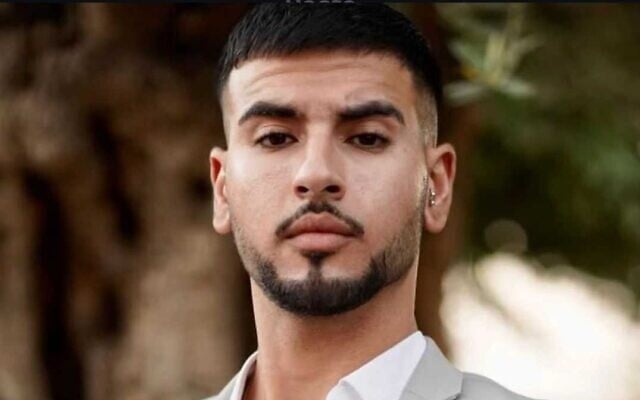 Sgt. First Class (res.) Michael Mordechai Nachmani (Israel Defense Forces)
Sgt. First Class (res.) Michael Mordechai Nachmani (Israel Defense Forces)Following the withdrawal, the IDF remains in control of just over half of the Strip’s territory, or 53 percent — most of which is outside of urban areas.
This includes a buffer zone along the entire Gaza border, including the Philadelphi Corridor — the Egypt-Gaza border area — along with Beit Hanoun and Beit Lahiya in the Strip’s far north, a ridge on the eastern outskirts of Gaza City, and large portions of Rafah and Khan Younis in southern Gaza.
In a tearful statement at a press conference, IDF Spokesman Brig. Gen. Effie Defrin said the ceasefire in the Gaza Strip was “an emotional moment for the people of Israel and for the IDF troops and soldiers who have fought and acted over the past two years with courage, bravery, and out of a sense of mission and dedication.”
Defrin showed the IDF’s current deployment in the Gaza Strip as part of the deal, and said that troops “will act to eliminate any threat to their security, no risks will be taken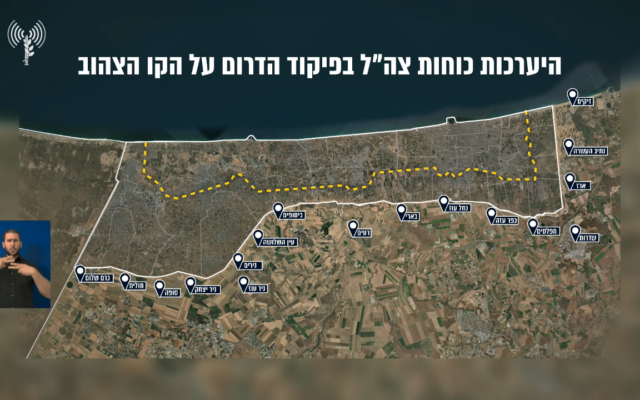
This map published by the IDF on October 10, 2025, shows the IDF’s deployment in Gaza following a ceasefire. (Israel Defense Forces)“We will do everything possible to protect the security of the residents of the western Negev, the south and the entire country,” he said.
Asked whether Hamas still poses a threat to Israel, Defrin said: “Hamas today is not the Hamas of two years ago; Hamas has been defeated everywhere we fought it.”
Both the IDF and Hamas’s Civil Defense agency earlier issued calls urging residents not to go near areas where Israeli forces were stationed in the Strip.
“According to the agreement, IDF troops will remain deployed in specific areas of the Gaza Strip. Do not approach IDF troops in the area until further notice. Approaching the forces exposes you to danger,” warned the IDF’s Arabic-language spokesperson Col. Avichay Adraee.
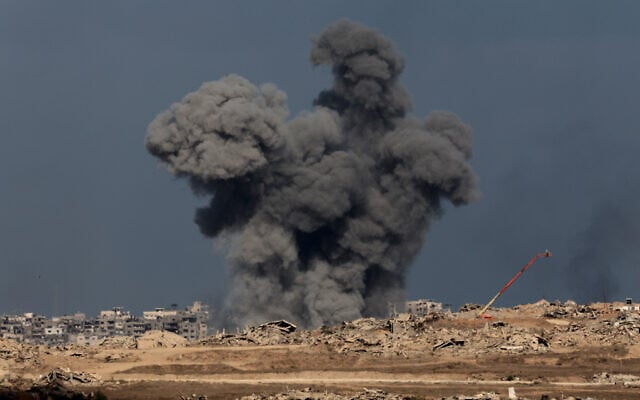 A smoke plume billows following Israeli strikes on the Gaza Strip as pictured from across the border in southern Israel on October 10, 2025. (Jack GUEZ/AFP)
A smoke plume billows following Israeli strikes on the Gaza Strip as pictured from across the border in southern Israel on October 10, 2025. (Jack GUEZ/AFP)Adraee said moving from southern Gaza to the Strip’s north, and vice versa, was permitted via the Rashid coastal road and the Salah a-Din highway.
“We warn you that in the northern Gaza Strip area, approaching the areas of Beit Hanoun, Beit Lahia, Shejayia and the areas where forces are stationed is extremely dangerous,” he said. “In the southern part of the Strip, it is very dangerous to approach the Rafah crossing area, the Philadelphi Corridor and all areas where forces are stationed in Khan Yunis.”
He also warned that along Gaza’s coast “there is great danger in fishing, swimming and diving. We warn against entering the sea in the coming days.”
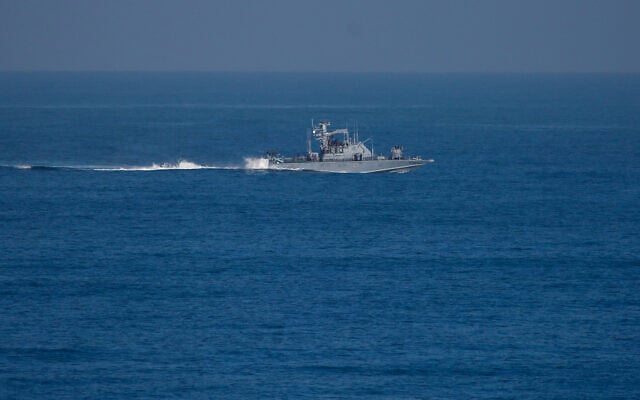 An Israeli navy ship patrols the waters, as seen from Nuseirat in the central Gaza Strip on October 10, 2025. (Photo by Eyad BABA / AFP)
An Israeli navy ship patrols the waters, as seen from Nuseirat in the central Gaza Strip on October 10, 2025. (Photo by Eyad BABA / AFP)Hamas’s Civil Defense agency also told Gazans not to approach the borders of the enclave until an official announcement is made about an IDF withdrawal. “Violating this warning puts your lives at risk,” the statement said.
Following the announcements, footage from Gaza showed hundreds of people beginning to move along the coastal al-Rashid Road moving back north toward Gaza City, the enclave’s main urban center which has been under Israeli assault for the past month.
The ceasefire between Israel and Hamas was announced in the early hours of the morning on Thursday and was ratified by the government later that evening. The hostages — some 20 living, at least 26 thought to be dead — are meant to come home within 72 hours of the completion of an agreed-upon withdrawal of the IDF.
The terror group has, in the past, told mediators it does not know where some of the bodies of slain hostages are located, which may delay the release of the bodies.
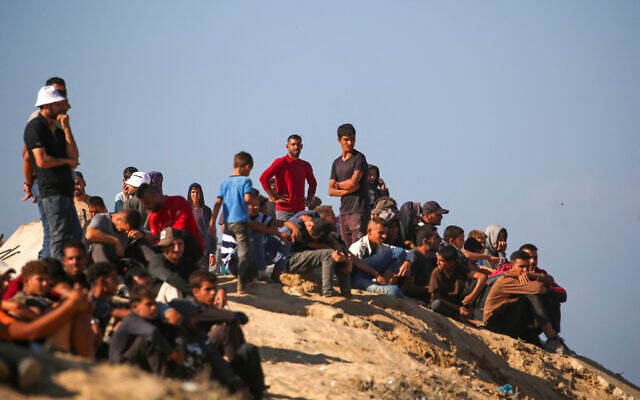 Palestinians look toward Gaza City from a hilltop in Nuseirat in the central Gaza Strip on October 10, 2025. (Photo by Eyad BABA / AFP)
Palestinians look toward Gaza City from a hilltop in Nuseirat in the central Gaza Strip on October 10, 2025. (Photo by Eyad BABA / AFP)Israel is due to release 250 Palestinian security prisoners serving life sentences, plus another 1,700 Gazans imprisoned since the October 7, 2023, Hamas-led attack that launched the war.
Meanwhile, the announcement of a ceasefire mixed emotions in Gaza, much of which has been flattened by Israel’s offensive and has seen much of the population displaced.
“Honestly, when I heard the news, I couldn’t hold back. Tears of joy flowed. Two years of bombing, terror, destruction, loss, humiliation, and the constant feeling that we could die at any moment,” displaced Palestinian Samer Joudeh told AFP.
Nevin Qudeeh said she felt the greatest sense of relief since the war erupted two years ago. She’ll be even happier, she added, when she can return home.
We’re staying on the streets.”
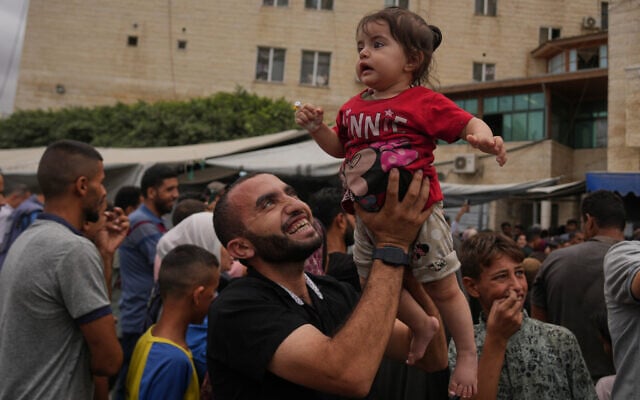 Palestinians celebrate following the announcement that Israel and Hamas have agreed to the first phase of a peace plan to end the war, outside Al-Aqsa Hospital in Deir al-Balah, central Gaza Strip, October 9, 2025. (AP Photo/Abdel Kareem Hana)
Palestinians celebrate following the announcement that Israel and Hamas have agreed to the first phase of a peace plan to end the war, outside Al-Aqsa Hospital in Deir al-Balah, central Gaza Strip, October 9, 2025. (AP Photo/Abdel Kareem Hana)“I am happy and unhappy,” said Mohammad Al-Farra. “We have lost a lot of people and lost loved ones, friends,” relatives, and homes that are about a lot more than stones and physical buildings, he said.
One cannot help but wonder what the day after would look like, he said — or where to even begin picking up the pieces. “The situation is very difficult.”
But he said they would overcome future hardships just like they’ve been doing.
Taghreed al-Jabali, displaced from Khan Younis, also shared the mixed feelings.
“We don’t know whether to feel happy or sad,” she said, lamenting the killings and losses of the last two years, including children missing two full years of school.
“Our sons and daughters didn’t receive an education. A whole generation was lost. Two generations were lost, not just one. May God make it up for us,” she said.
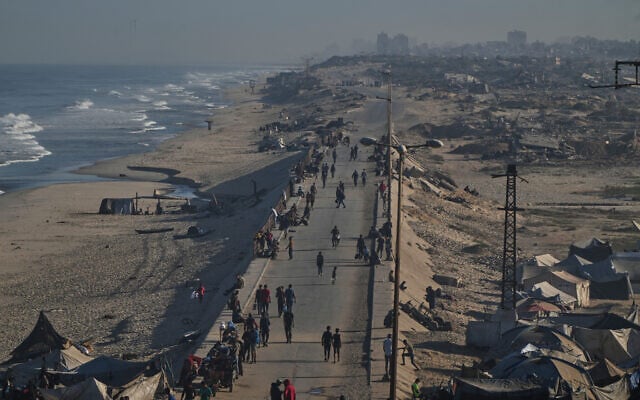 Displaced Palestinians walk along the coastal road near Wadi Gaza in the central Gaza Strip, October 10, 2025. (AP Photo/Abdel Kareem Hana)
Displaced Palestinians walk along the coastal road near Wadi Gaza in the central Gaza Strip, October 10, 2025. (AP Photo/Abdel Kareem Hana)The war erupted when Hamas-led terrorists rampaged through southern communities on October 7, 2023, murdering some 1,200 people, mostly civilians, and taking 251 hostages.
The Hamas-run Gaza health ministry says more than 67,000 people in the Strip have been killed or are presumed dead in the fighting so far, though the toll cannot be verified and does not differentiate between civilians and fighters. Israel says it has killed over 22,000 combatants in battle as of August and another 1,600 terrorists inside Israel during the October 7 onslaught.
Israel has said it seeks to minimize civilian fatalities and stresses that Hamas uses Gaza’s civilians as human shields, fighting from civilian areas including homes, hospitals, schools and mosques. Link
Reports: Israel assesses that Hamas may release hostages earlier than expected; deadline for release is noon Monday
Israel currently believes that Hamas may release all remaining hostages earlier than previously expected, according to reports in Hebrew media, with some saying the scheduled release day is now Sunday instead of Monday, which is the deadline for their release.
“It could happen any day now from this moment on,” a senior Israeli official says. The official notes, however, that there has been no confirmation that Hamas will release hostages before Monday.
Israel has demanded that all hostages be released in one phase. Still, it is prepared for the possibility that the release could occur in multiple stages, as long as it is completed within the 72-hour timeframe that ends at noon on Monday.
If Hamas does not release all the living hostages by that deadline, Israel will consider it a violation of the ceasefire agreement.
Hostage families gather to mark final Shabbat without their loved ones
Families of hostages held in Gaza gather in Tel Aviv’s Hostages Square for a Shabbat dinner, which they say they hope will be the last one without their loved ones ahead of their expected release early next week.
“Dear people of Israel – we need you now more than ever,” says Einav Zangauker, mother of hostage Matan Zangauker. “Our struggle is not over until all 48 hostages are returned home.”
“We’re in a storm of emotions,” she adds. “We’re anxious and know nothing beyond what you also know. We’re here to share, to be with you. Shabbat Shalom, we love you.”
Arbel Yehud, who was freed from captivity during the ceasefire earlier this year, spoke about the strength she drew during her time in Gaza while waiting for her partner, Ariel Cunio, who remains in captivity: “More than two years have passed since we were cruelly torn apart. The hope of meeting again, the thought of our embrace at the end of this horror film, is what kept me going. My love, we did it – just a little longer and you’ll be home.”
**There is nothing more important than getting them home! NOTHING!**
“I’ve never met them,But I miss them. I’ve never met them,but I think of them every second. I’ve never met them,but they are my family.
Red Alerts - Missile, Rocket, Drone (UAV - unmanned aerial vehicles), and Terror Attacks and Death Announcements
*
The Nova Tribe Community Association mourned Roi Shalev, who took his own life nearly two years after the October 7 massacre. "Roi was one of the pillars of the community and his death is an inconceivable news for us. We share in the grief of the family, friends and the community in their profound loss," they stated. "Unfortunately, many PTSD victims are still experiencing terrible and complex moments since October 7. We ask everyone to remain constantly vigilant and maximally sensitive to the mental state of victims in general and particularly to the party survivors and bereaved families. If you identify someone who needs psychological help, please report immediately to the police, to us - the Nova Association or to mental health support services." (Story about Roi Shalev below in Personal Stories)
"I am still on the kitchen floor facing the terrorists, waiting for him to return"
"I need to remind myself that I am alive many times": Lishi and Omri Miran have been married only five years, two of which he has been in captivity. Next week Omri will finally return to her and to their two little daughters. The one who connected with Lishi from the first moment was Avital (Mili) Dekel Chen. After Sagi returned, Mili did not leave—and recently has become a kind of mentor to her: the one who knows how to tell how to prepare for a husband, for a father returning home.
"There is one sentence of his that I made into a tattoo last year: 'Only with you I am free,' that is the last sentence of Omri," points out Lishi Miran to her arm when she meets with Avital (Mili) Dekel Chen. For already 735 days Omri Miran has not been free: not he, not his wife Lishi, and not the daughters Roni and Alma. But now, maybe now, it is finally happening.
The message that Omri is returning home caught Lishi in the United States, on another journey she set out on to press for a deal. "I am not there," she says regarding the question of what she will say to Omri the first time they meet after two years, and Avital agrees with her on a video call: "I did not prepare a bag for Sagi, I was trembling, I did not agree to prepare him personal things, I was so afraid that Murphy would strike me and I said, 'I am not preparing anything,'" and Lishi clarifies: "When Omri will be here, then there will be everything."
"Clinging to one another, with hope"
The friendship between Lishi and Avital was woven within long days of struggle. Together they were at rallies, in committees, in interviews, in conversations about what else could be done that was not done. "In this journey, which is still not over, we found ourselves talking and texting at all hours, sharing the small and big things, clinging to one another and keeping the hope," she told at a demonstration alongside Avital. "Even when some of us received the bitter news, we decided that with us it would be different, because there is no other option."
In February Sagi returned. Mili received her beloved back, and Lishi did not—and still, their friendship held. During the past two years Hamas released two signs of life from Omri, the last one of them six months ago.
"I remember your first meeting with Sagi, when you were so emotional—the moment that you come home and you hug him, I started crying because I felt that in some place it was as if you were hugging Omri, as if you were saying 'you are the closest to the situation my husband is in now,' and also Sagi felt that, and afterward it broke him," recalls Mili.
And Lishi shares: "It happens that I am also with Keith and Aviva Sigal, and Keith is actually the last who was with Omri. It was already so long ago, more than a year. He saw him last in July and then they parted. On the 700th day of the abduction we held such a rally in Sha’ar HaNegev and he and Aviva came, and it was the first time he saw the girls. In the most honest way, I had the urge to tell Roni 'you know, Keith was with Dad,' and I stopped it. I said to myself—you cannot do that to her, maybe it will not do her good to feel so close."

"When Omri will be here, then there will be everything." Lishi and Avital
"Our whole story is bizarre"
"You know that people do not know that you are only like five years together, and almost half of the time… to whoever watches you and sees everything you do for him, it looks like you really have been together twenty years," Mili tells her, and Lishi answers: "Yes, because it is crazy, because our whole story is bizarre."
"Omri and I met more than a decade ago, just before Operation 'Protective Edge,' when he came and had just moved to live here and I was still married, I was in processes of separation, in processes of divorce, and they told him 'keep your distance.' After two years he asked about me again and they told him 'keep your distance,' and after another three years we simply met at a Purim party, and we did not move from each other that day."
When Lishi and Omri got married, Roni was already two years old, that was three years ago. Since then Alma was also born, who was a six-month-old baby when her father was abducted. Lishi’s parents, who lived in Sderot, left the city on the eighth of October, the moment it was possible, and joined her in Kramim, the kibbutz to which she was evacuated with other families. Since then they have not returned to their home, and they take a huge part in raising the girls. "When you ask Roni today, Alma, who is your family? 'Mom, Dad, Grandpa, Grandma,'" she explains. "There were moments in the first months that I was sure that Alma was already beginning to get confused because also her mother disappeared in some place."
Lishi and Omri Miran on their wedding day"Roni woke up with a weapon pointed at her head"
And maybe now, when Omri returns, Lishi will also be able to process what she herself went through on October 7th: "When the shooting started in our area, we put Roni to sleep on her bed and I and Alma hid here, in the closet, and Roni was in direct line to me," she demonstrates inside the safe room. "Omri stood here at the door with two sacks."
Tomer Arava, the son of the neighbors, was forced by Hamas to go from house to house to convince the residents to open the door. "When we heard Tomer, Omri opened the door. He told us to go outside, that if we do not come out they will murder him and us, and said that it already happened. They take us to our kitchen, sit us there, and it took me two minutes to pull myself together and understand that I am only with one child at all and Roni stayed here in the room, because they simply took Omri out by hand and they took me out by hand with Alma on me and Roni was sleeping, she shut herself off completely. Tomer is the one who got up to bring Roni, he is brave, he is the hero."
"Roni was completely dazed, she did not really understand what was happening—a two-year-and-two-month-old girl, a weapon pointed at her head, a weapon pointed at her father’s head, a weapon pointed at her mother’s back, and that is how she woke up. We are led to the neighbors’ house, the live broadcast on Facebook is not from our house but from the neighbors’ house, and there we sit a few hours together, two families, at the end of which actually Omri was abducted, Tzahi Idan, of blessed memory, was abducted together with him, and Yehudit and Natalie Raanan, the first who were released."
"They (the terrorists) took Tomer to continue, he thought he was staying with us. He managed to stay with us forty-five minutes, that was the longest time apparently that he was in a house with people and they did not move him on, until in the end he managed to escape and was killed at the entrance to the kibbutz."
"When he returns, he will lift you up from the floor"
"You are still in the safe room in Nahal Oz, until he returns," Mili tells her, and Lishi agrees: "I am still on the floor in the kitchen, completely," and Mili explains: "And when he returns he will lift you up from that floor and then you will understand the magnitude of the event and understand what happened to you. And when you call to tell me 'listen, I am in a bad mood,' I will tell you 'wow, it is okay, it happens, it will happen to you, you will see.'"
The family of Omri Miran in the Hostages Square | Photo: Avshalom Sassoni, Flash 90
Mili invited Lishi a gift for water therapy so that she could for a moment disconnect, relax. But the time, suddenly, alone with herself, brings not simple thoughts. "It is impossible to really escape from it, it will be here and it will be at home and it will be in the bed and it will be in the morning. In the first months when I woke up in the morning I had to touch my face because I did not believe that I am here, I was touching and looking at Roni and Alma and understanding that we are really here, that I am really alive. Another day passes and another day and another day, and I need to remind myself that I am alive many times."
"How is Sagi now? I want to tell you that he is in a good place, but I do not think he is in a good place, and I want at the same time to wish for you to reach that place, but it is not the best place to be," shares Mili. "Roni and Alma, surely they will be interested that he returned from captivity, but after a month they will tell him 'Dad, you annoy me,' 'Dad, I want you to come with me to the playground,' and he will have to somehow rise above the mood, the difficulty he has, the physical and mental state, and say 'now they need me,' but he himself needs help."
And Lishi remembers: "Yesterday Alma says 'I want to see Dad for real' and Roni says to her 'Dad is in Gaza,' and then the conversation begins so I asked them 'what do you want to do with Dad?' and they said to me 'nothing, only that he will be'." link
US troops begin arriving in Israel to oversee Gaza ceasefire
US troops begin arriving in Israel overnight as part of a force that will help oversee the Gaza ceasefire, ABC News reports.
The report, citing two officials, says that the 200-strong team will arrive over the weekend, flying in from the US and other bases across the Middle East.
Admiral Brad Cooper, the head of the US military’s Central Command, arrived in Israel yesterday.
Officials have said that US personnel were intended to help create a joint control center and then integrate all the other security forces that will be going into Gaza and help liaise with the IDF.
Egyptian, Qatari, Turkish and probably Emirati military officials will be embedded in the team, likely based out of Egypt. Officials have said no US troops are intended to go into Gaza.
Masses begin returning to Gaza City as IDF withdraws, opens coastal road
People chant ‘God is great’ as they return to check on their homes where IDF offensive took place; Gazans begin clearing rubble from destroyed buildings in Khan Younis
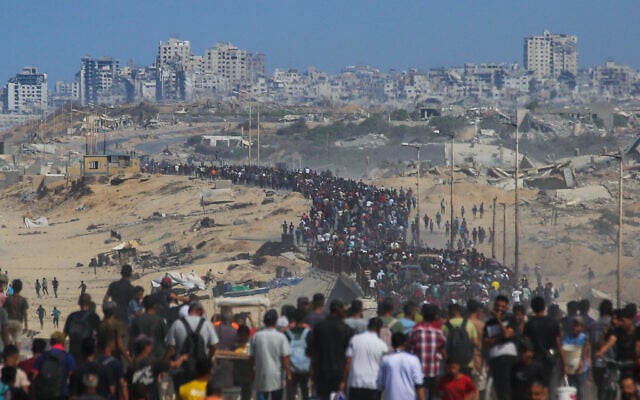
Palestinians walk along Al-Rashid Road toward Gaza City from Nuseirat in the central Gaza Strip, on October 10, 2025. (Bashar TALEB /
Full of grief after two years of war but glad to be going home, thousands of displaced Palestinians set off across the Gaza Strip on Friday, as a truce between Israel and Hamas took hold.
Timidly at first, then in a huge column, thousands walked northwards in a line at least a kilometer long from the safer areas of central Gaza towards Gaza City, the scene of a grueling Israeli offensive before Friday’s ceasefire.
People chanted “God is great,” cheering and whistling in their joy as they walked on a recently opened Mediterranean seafront road, AFP journalists saw.
Ibrahim al-Helou, a 40-year-old man from Gaza City displaced in the central refugee camp of Al-Maghazi, told AFP he was excited, but remained cautious.
He said that when he began heading home, “the situation was dangerous, with gunfire, so I waited for a while.”
Now, the road has been opened and we have all continued on our way back to Gaza to check on our homes and assess the situation.”
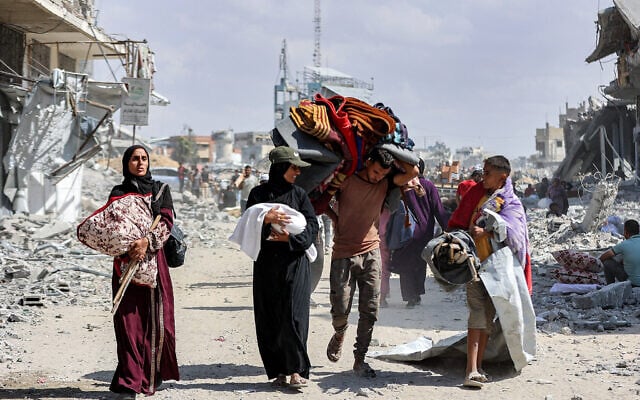 A woman carrying a child speaks with another boy as they walk with other people past the rubble of destroyed buildings in the center of Khan Yunis in the southern Gaza Strip on October 10, 2025, as displaced people return to their homes after Israeli forces’ withdrawal. (Photo by Omar AL-QATTAA / AFP)
A woman carrying a child speaks with another boy as they walk with other people past the rubble of destroyed buildings in the center of Khan Yunis in the southern Gaza Strip on October 10, 2025, as displaced people return to their homes after Israeli forces’ withdrawal. (Photo by Omar AL-QATTAA / AFP)Ahmad Azzam, a 35-year-old who was also displaced to central Gaza from Gaza City, said he moved as soon as he heard of the troops pulling back.
“When I heard news of the Israeli withdrawal and that the road would be opened in the coming hours, my family and I immediately headed to Al-Rashid Street to return to Gaza,” he told AFP.
He added that, like Helou, he found the situation dangerous at first, and initially chose to wait on a hill overlooking the coastal road.
“Only a few people are risking moving forward,” he said, speaking at noon, the time the troops’ pullback officially ended.
The military said Friday that troops had completed a withdrawal to agreed-upon deployment lines in the Gaza Strip on Friday at noon, officially beginning the ceasefire.
It said in a separate statement in Arabic that Gaza’s main north-south axis, Salah Al-Din Road, had also been reopened, but warned Gazans against approaching army troops still stationed inside the Palestinian territory.
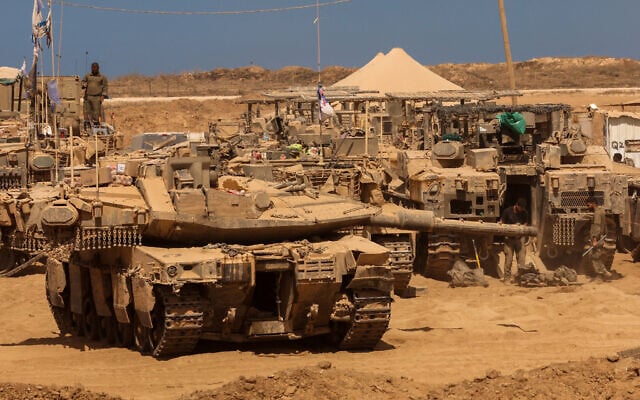 IDF soldiers conduct maintenance work on their armored vehicles at a position along the Israel-Gaza border, on October 10, 2025. (Jack GUEZ / AFP)
IDF soldiers conduct maintenance work on their armored vehicles at a position along the Israel-Gaza border, on October 10, 2025. (Jack GUEZ / AFP)Under a plan proposed by US President Donald Trump, the military was to withdraw to the so-called Yellow Line. During this first part of the withdrawal process, the military will still hold about 53 percent of the Gaza Strip.
‘Running’
In the southern city of Khan Younis, dozens walked back to their homes on paths cleared through piles of rubble accumulated from over two years of war and air strikes, an AFP journalist reported.
Destroyed and damaged buildings, their facades torn off by blasts or crumbling upon their foundations, stood on all sides as the returnees walked in the morning sun, shortly after news spread that Israeli forces had withdrawn from parts of Khan Younis.
“We’re happy. Even if we return to ruins with no life, at least it’s our land,” Ameer Abu Iyadeh, a returnee, told AFP.
“We’re going back to our areas, full of wounds and sorrow, but we thank God for this situation,” he said, smiling, a pink school backpack strapped to his chest, holding a jerrycan full of water in one hand and his young daughter in the other.
“God willing, everyone will return to their areas,” the 32-year-old said, while his two other daughters walked by his side, holding hands.
Areej Abu Saadeh, a Palestinian woman who lost a daughter and a son during the war, said she could not wait to get home.
“We’ve been displaced for two years now, living on the sidewalks with no shelter and nowhere to stay,” she told AFP.
“We’re now on our way to Bani Suheila, running — I just want to reach my place,” she said, referring to her town east of Khan Younis.
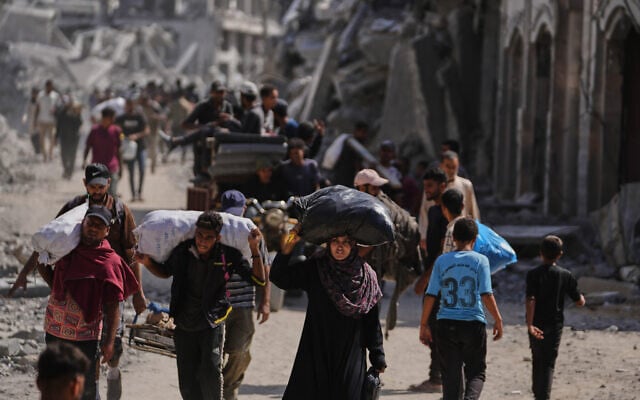 Displaced Palestinians walk with their belongings past destroyed buildings as they return to their homes in Khan Younis, in the southern Gaza Strip, October 10, 2025. (AP Photo/Jehad Alshrafi)
Displaced Palestinians walk with their belongings past destroyed buildings as they return to their homes in Khan Younis, in the southern Gaza Strip, October 10, 2025. (AP Photo/Jehad Alshrafi)The cabinet voted early Friday in favor of a resolution providing for all hostages to be freed in the coming three-to-four days in exchange for Palestinian security prisoners, and for an end to the war in Gaza.
The hostages — some 20 living, at least 26 thought to be dead — are meant to come home within 72 hours of the completion of an agreed-upon withdrawal of the IDF.
The terror group has, in the past, told mediators it does not know where some of the bodies of slain hostages are located, which may delay the release of the bodies.
Israel is due to release 250 Palestinian security prisoners serving life sentences, plus another 1,700 Gazans imprisoned since the October 7, 2023, Hamas-led attack that launched the war. Link
Some 200,000 people have returned to northern Gaza since ceasefire began, Hamas-run civil defense says
Gaza’s Hamas-run civil defense agency says that approximately 200,000 people have returned to the north of the territory since a ceasefire took effect earlier today after the IDF withdrew from much of the territory.
“Approximately 200,000 people returned to northern Gaza today,” says Mahmud Bassal, spokesman for the agency, a rescue force operating under Hamas authority.
Hamas-run civil defense agency says 55 bodies recovered as Israeli forces pull back in Gaza
Gaza’s Hamas-run civil defense agency says more than 50 bodies were recovered from the wreckage and brought to hospitals across the territory today after Israel declared a ceasefire and started pulling back troops.
Mohammed al-Mughayyir, an official within the rescue force, says at least 55 bodies had been retrieved. He does not give further details about when or how the people were killed.
The director of Al-Shifa Hospital, Mohammed Abu Salmiya, tells AFP that 33 of the bodies were brought to hospitals across Gaza City, which was the scene of a grueling Israeli offensive before Friday’s ceasefire.
He says that one of the dead had been “targeted today by Israeli fire near the Baraka area in Sheikh Radwan, north of Gaza City.”
The civil defense confirmed that Israeli troops and armored vehicles were pulling back from forward positions in both Gaza City and the southern city of Khan Younis, as part of the IDF withdrawal.
Gaza terror organizations: We will not accept foreign rule in the Strip - this is a Palestinian matter
Hamas, Islamic Jihad and the Popular Front for the Liberation of Palestine issued a statement regarding the agreement to end the war, denying they would accept any "foreign rule." The terror organizations noted that governance in Gaza is a "Palestinian matter," but expressed willingness for Arab countries and the international community to participate in rebuilding the Strip. They also emphasized that so far, agreement has been reached "on implementing the first phase" of the deal. Finally, the organizations pledged to continue working for the release of the remaining Palestinian prisoners detained in Israel'Go to hell': Hamas official walks out of TV interview after clash over October 7 and Gaza war
In fiery interview, Mousa Abu Marzouk storms off air after being asked if Oct. 7 advanced Palestinian goals, exposing rare anger and growing Arab frustration with Hamas’ leadership; ‘This reaction sadly exposes the mindset of the Hamas leadership,’ host replies
A heated on-air confrontation erupted Friday night on the Emirati-funded Al Ghad television channel when senior Hamas official Mousa Abu Marzouk angrily cut off a live interview after being pressed with tough questions about the Oct. 7 attacks and the devastating impact of the war on Gaza.Abu Marzouk, one of Hamas’ founding members, sought to justify the group’s actions, saying Hamas had “fulfilled its national duty.” He added that “we did what reality imposed upon us — resistance to occupation, against oppression, settlements and the imprisonment of our people in Israeli jails.”When asked whether the war had truly advanced the goal of Palestinian liberation, Abu Marzouk replied vaguely: “We will assess everything — where we succeeded and where we erred. But this is not how a campaign is measured. No one expects a liberation movement to achieve everything in one day.”Tension rose when the interviewer pressed further, asking whether Oct. 7 was ever a path toward freedom or independence. Visibly irritated, Abu Marzouk responded, “No sane person would claim that on October 7, with just a thousand or so fighters, it was possible to liberate Palestine.” He then demanded, “Please, at least make your questions respectful.”The interviewer, maintaining a calm tone, replied that he was raising “the questions being asked on the Palestinian street, from the residents of Gaza.” At that point, Abu Marzouk lost his temper, shouting, "These are your questions! Show some respect for yourself. I don’t want to speak with you. I don’t want to see you. Cut it. Cut it. Go to hell!Taken aback but composed, the interviewer responded, “Excuse me, Mr. Mousa Abu Marzouk, I will not allow you to speak to me this way. This reaction sadly exposes the mindset of the Hamas leadership—the attempt to evade serious questions and real dialogue at this stage, in the face of the genocide against the Palestinian people.”The exchange quickly went viral on social media and was seen as a rare public display of anger by a senior Hamas figure toward Arab media. Commentators in Arabic outlets described it as evidence of growing internal strain within Hamas since the war began — and of rising frustration among Arab audiences, particularly in the Gulf, over the destruction in Gaza.The incident also underscored the widening gap between Hamas leadership and much of the Arab public, who have been increasingly critical of the heavy human toll in Gaza.Fatah spokesman Jamal Nazzal called the exchange “a disgrace that exposes the moral and political bankruptcy of a crumbling group that can no longer look people in the eye.” Link- Hamas arrested 'collaborators' in Gaza: 'Striking the nests of traitors'The Hamas-affiliated Al-Quds network reported from a source in the terrorist organization that several "fugitives from justice" were arrested in northern Gaza Strip, as part of Hamas' activity to take revenge on its rivals in the Strip under the cover of the ceasefire. Hamas' security apparatus unit "Radaa" had previously announced that "from the north of the Strip to the south, Radaa's hand is striking the nests of traitors and collaborators at these moments.

IDF says it seized Hezbollah weapons cache, demolished building in southern Lebanon
Israeli troops demolished a building in southern Lebanon’s Ayta ash-Shab where a cache of weapons belonging to the Hezbollah terror group was located, the military says.
The IDF says reservists of the 300th “Baram” Regional Brigade scanned the building early this morning following intelligence information that it was being used by Hezbollah.
The soldiers seized the weapons being stored in the building before blowing it up, the army says.
Beirut, Damascus seek to reset ties as Syrian FM visits Lebanon
Lebanon and Syria say they are committed to turning a new page on ties as Damascus’s foreign minister visits Beirut, with Lebanon seeking information on political assassinations under the Assad dynasty.
The family of Bashar al-Assad, ousted in December, exercised control over Lebanese affairs for decades and was accused of assassinating numerous officials in Lebanon who expressed opposition to its rule.
“Today we have opened a bright new page in relations between Syria and Lebanon,” says Foreign Minister Asaad al-Shaibani, the first senior Syrian official to visit Lebanon since Assad’s toppling.
He says the trip demonstrated “a new Syrian approach towards Lebanon,” involving respect for its sovereignty and non-interference in its internal affairs.
President Joseph Aoun says Lebanon looked forward to strengthening ties between the two countries “on the basis of mutual respect and non-interference in domestic affairs.”
Lebanese media reports overnight Israeli strikes destroyed 300 vehicles
The overnight Israeli airstrikes in southern Lebanon killed a Syrian national and wounded six other people, Lebanese media reports.
According to Lebanon’s National News Agency, the strikes hit more than 10 yards where engineering vehicles were stored. NNA says some 300 vehicles, including bulldozers and excavators, and over 100 small Bobcat utility vehicles, were destroyed in the strikes.
The IDF said the airstrikes had targeted Hezbollah sites where the terror group was storing heavy machinery to use “for rebuilding its terror infrastructure in southern Lebanon.” video. more videos
Lebanese president slams Israel for overnight strikes that killed one, wounded sevenBEIRUT, Lebanon — Lebanese President Joseph Aoun condemns Israel for carrying out overnight strikes that the health ministry says killed at least one person.
“Once again, southern Lebanon has been the target of a heinous Israeli aggression against civilian installations — without justification or pretext,” Aoun says. “The seriousness of this latest attack lies in the fact that it comes after the ceasefire agreement in Gaza.”
The ministry says an Israeli strike on the Al-Msayleh area left one person dead and seven others wounded. The official National News Agency says Israeli warplanes conducted 10 raids targeting bulldozer and excavator yards.
The Israel Defense Forces said that it struck sites where Hezbollah was storing heavy machinery to use “for rebuilding its terror infrastructure in southern Lebanon.”
AFP photographer injured in settler attack on West Bank olive harvest
An AFP photographer is injured after an attack by Israeli settlers on Friday while covering the olive harvest in a Palestinian village in the West Bank.
“In my 30-year career, this is the first time I have faced violence of this kind,” says Jaafar Ashtiyeh, a Palestinian photographer based in the city of Nablus.
“If I hadn’t managed to escape, they would have killed me,” he adds.
Ashtiyeh says he had been covering the olive harvest in the village of Beita, particularly looking at the work of Israeli and foreign peace activists who had come to support residents in the face of repeated settler attacks during the harvest season.
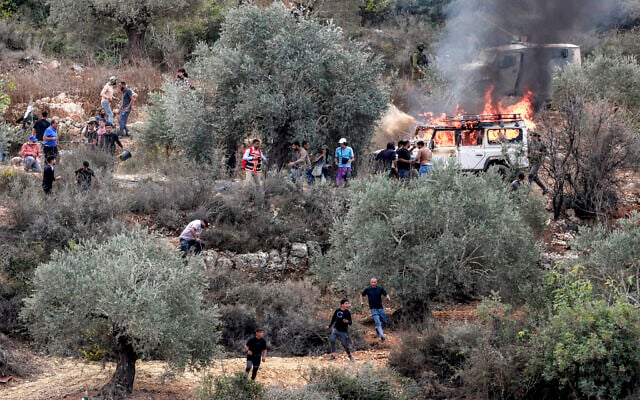 Israeli army soldiers and an armoured vehicle deploy (top R) behind as Palestinian men and first-responders attempt to extinguish a vehicle that was set ablaze during an attack by Israeli settlers on Palestinians and other activists who had gathered for the annual olive harvest season in the Palestinian village of Beita, south of Nablus in the West Bank, on October 10, 2025 during the annual olive harvest season. (Jaafar ASHTIYEH / AFP)
Israeli army soldiers and an armoured vehicle deploy (top R) behind as Palestinian men and first-responders attempt to extinguish a vehicle that was set ablaze during an attack by Israeli settlers on Palestinians and other activists who had gathered for the annual olive harvest season in the Palestinian village of Beita, south of Nablus in the West Bank, on October 10, 2025 during the annual olive harvest season. (Jaafar ASHTIYEH / AFP)Shortly after midday, two groups of Israeli settlers armed with sticks and stones — numbering around 70 people in total — attacked the olive pickers and journalists at the scene.
Hit by several stones in the back, arm and hand, Ashtiyeh says he was discharged from the hospital in the afternoon and is suffering from bruising.
His car, along with a handful of others parked at a safe distance from the field, was stoned and then set on fire by the assailants.
Ashtiyeh says Israeli soldiers who were present before the attack did nothing to stop the attackers from advancing, but instead fired tear gas and rubber bullets at the olive pickers and activists to disperse them.
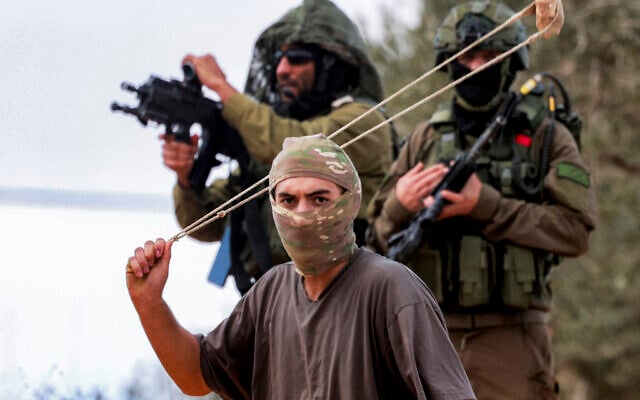 Israeli army soldiers stand behind a masked man swinging a slingshot while hurling stones at Palestinians who had gathered for the annual olive harvest season, during an attack by Israeli settlers on the Palestinian village of Beita, south of Nablus in the West Bank, on October 10, 2025. (ASHTIYEH / AFP)
Israeli army soldiers stand behind a masked man swinging a slingshot while hurling stones at Palestinians who had gathered for the annual olive harvest season, during an attack by Israeli settlers on the Palestinian village of Beita, south of Nablus in the West Bank, on October 10, 2025. (ASHTIYEH / AFP)“We strongly condemn this outrageous attack, which is another illustration of the increasingly dangerous working environment for our journalists in the West Bank,” says Mehdi Lebouachera, AFP’s Global Editor-In-Chief.
“We urge the Israeli military to not only ensure the protection of journalists going about their work but also to ensure that the perpetrators are brought to justice,” he adds.
The IDF did not immediately respond when asked for comment on the incident.
The Palestinian health ministry says settler attacks injured 36 people on Friday in Beita and other nearby villages, with most of them suffering minor or moderate injuries, with the exception of two who were wounded by gunfire.
- Politics and the War and General News
The lost months: could it have been possible to reach a hostage deal earlier?
One of the debates that will accompany us from now until the elections, whenever they may be, is the question of whether it was possible to reach a similar hostage deal much earlier. Who refused and why? What conditions were added in the decisive moments? And what are the differences between the moves that were discussed a year and two years ago and the current agreement? We went back to the times when we were on the verge of a deal – and why it fell through.
For two long years of bloody war, millions of Israelis waited for this moment. Many believed that such a deal was not possible: on the right they explained that Hamas would never agree to give up all the hostages and would always want to keep some bargaining chips, and on the left they claimed that Netanyahu would do everything to thwart such a deal in order to maintain the coalition’s stability. And yet, the President of the United States Donald Trump proved that if you apply enough pressure, it is possible to produce results.However, looking back, it is not at all certain that it was impossible to reach such an agreement or at least get very close to it – much earlier. And the history of the missed opportunities begins already in October 2023, even before the first IDF force crossed the border into the Gaza Strip.
The reactions in Hostage Square to the announcement of the deal | Photo: Reuters
According to an investigation by “HaMakor” broadcast on Channel 13, already in the first days after October 7, Hamas offered the Americans through the Qataris to release some of the hostages, but in Israel they were not ready even to raise it for discussion. In the war objectives that were formulated on October 7, there was no mention of the hostages and their return – that goal was added only after the joining of Benny Gantz and Gadi Eisenkot to the government.“There is no situation in which we do not return to fighting”
At the end of November 2023 the first hostage deal was launched, and it included only women and children, and even to this deal some members of Otzma Yehudit objected. During seven days 104 civilians were returned. In Hamas they were sure that the dynamic would continue and lead to the end of the war but in Israel there was no such intention.“I hear the question: after exhausting this stage of returning our hostages, will Israel return to fighting? So my answer is unequivocally yes. There is no situation that we do not return to fighting until the end,” Netanyahu declared then. And that would be Netanyahu’s policy throughout all the negotiations with Hamas – to clarify that Israel would have the option to resume fighting without violating the agreement.
A Red Cross vehicle containing the hostages on their way to Israel in the first hostage dealAfter seven nights of releases, the eighth release got stuck. According to the agreement, another ten women were supposed to be released, but Hamas tried to claim that they were dead and offered instead to return seven bodies, two men and one woman. The position of the defense establishment was to insist, even at the cost of blowing up the deal. “Hamas blatantly violated the agreement we reached with the U.S., Egypt and Qatar,” declared then Defense Minister Yoav Gallant.
“The deal was dismantled in haste”
Opinions in the cabinet were divided, but as Yaron Avraham revealed in September 2024, the tough approach also aligned with the positions of Netanyahu’s right-wing coalition partners: “Our goal was to continue the dynamic of the release, but into the room already entered an atmosphere of coalition threats,” said then a senior minister. “That was the biggest miss. It was right to exhaust the move – and move on to another category. It was possible to bring back the elderly who later died in captivity, it was possible to return Yarden Bibas home on a humanitarian basis. But instead – the deal was dismantled in haste.”At the beginning of December 2023 Israel returned to fighting, and the contacts for a deal were frozen. Even when an Egyptian proposal arrived for three stages of ceasefire, at the end of which would be the end of the war and the return of all the hostages, Israel refused. Along the way there were ministers who consistently opposed and boasted that they torpedoed deals by threatening to dissolve the government: Itamar Ben Gvir said from the Knesset podium that “this government will have no right to exist,” and Bezalel Smotrich made it clear that he “opposes a deal in which the keys (amount of Palestinian prisoners to be released in return for the number of hostages) are larger, and the pause is larger.”
Against the background of the threats of his coalition partners, the prime minister also began to delay even the initial contacts between the sides directly and indirectly. “We are working to achieve another framework for the release of our hostages, but I emphasize, not at any price. I have red lines, we will not agree to every deal and not at any price,” he declared.
While Prime Minister Netanyahu hardened his positions, professional officials nevertheless tried to achieve a humanitarian deal. “The U.S. is working on a hostage deal between Israel and Hamas, which will bring an immediate and lasting calm in Gaza,” said Biden.
The move that led to another explosion in the negotiations
In mid-February 2024 the then-president declared that there was reason for optimism, but Netanyahu refused to be flexible, did not expand the mandate of the negotiation team, and avoided convening the cabinet. “Israel is not the one preventing a deal, Hamas is preventing a deal,” he said.Only about two months after Biden’s declaration, the war cabinet meeting concluded on the minimum number of hostages for which Israel would agree to an interim deal, and decided to keep it classified. But while the Israeli negotiation team was sitting with the Egyptian delegation, the developing proposal was leaked to Minister Smotrich, who again threatened: “This is a reckless deal, I will dissolve the government – if, heaven forbid, you decide to raise the white flag, the government under your leadership will have no right to exist.”
The threat took effect and Netanyahu changed the mandate of the Israeli team, behind the backs of his partners Gantz and Eisenkot. Yaron Blum, who served as the coordinator of prisoners and missing persons under Prime Minister Netanyahu from 2017 to 2022, explained: “Every such restriction greatly affects the negotiations, greatly hinders the negotiations, stops the negotiations.”
In May 2024 Israel already agreed to discuss a long ceasefire in the Strip, but then Netanyahu ordered an entry into Rafah, ostensibly to apply pressure on Hamas. In practice the move led to an explosion in the negotiations. After the publication of the video of the female lookouts’ abduction, public pressure intensified again.
The negotiation team renewed contacts for a deal and in the war cabinet approval was given to what would be called “the Netanyahu framework,” at the end of which all the hostages were supposed to be released, and in return Israel would commit to cease fire: a sustainable calm that would lead to a permanent ceasefire, withdrawal of IDF forces from the entire Strip, rehabilitation of Gaza, opening of border crossings, and easing of the movement of people and goods.
Netanyahu’s statement regarding a partial deal
“Israel offered a new and comprehensive ceasefire agreement, this is a framework for a lasting ceasefire and the release of all the hostages,” said Biden then. But although the prime minister formulated the framework that Biden presented, of the return of all the hostages in exchange for a long ceasefire, Netanyahu’s office hurried to disassociate from it and the right-wing partners again published threats. “If Prime Minister Benjamin Netanyahu continues to lead this deal, we will dissolve the government,” claimed Ben Gvir, and Smotrich added on June 3: “We will stand against you with all our power and determination if you choose surrender and defeat.”The prime minister took the statements seriously and contrary to the proposal he himself had formulated, declared his real intentions in an interview on Channel 14: “I am ready to make a partial deal, it is no secret, that will return to us some of the people but we are obligated to continue the war after the pause, to complete the goal of eliminating Hamas.”
In parallel with the operation in Rafah the negotiations continued, in Israel indications were received that Hamas tended to accept a deal even at the price of waiving the demand for an Israeli declaration of the end of the war. But then new demands emerged in Jerusalem: Israel announced that it would not agree to the return of armed men to the north of the Strip, and would not allow the smuggling of weapons to Hamas from Egypt – the Philadelphi corridor became for the first time our existential rock. According to Blum, “Until a few weeks ago I did not even know that the Philadelphi corridor was such an important thing, they will manage without the Philadelphi corridor, they will manage without the Netzarim corridor, when we need to we will enter there again.”
Even in the negotiation team they were surprised by Netanyahu’s statement. The head of the Mossad and the head of the Shin Bet nevertheless tried to advance a framework, but Netanyahu insisted in writing on only a thinning of the forces in Philadelphi without leaving it completely – in that same clarification document submitted to the Americans, also appeared the names of Carmel Gat, of blessed memory, Eden Yerushalmi, of blessed memory, and Hirsch Goldberg-Polin, of blessed memory, who were murdered shortly afterward in a tunnel in Rafah.
For almost a year the negotiation teams did not succeed in reaching a breakthrough. In Netanyahu’s office they claimed that he accepted all the American proposals and Hamas was the one who refused, and representatives of the Biden administration also backed those statements – at least in public declarations. Matthew Miller, spokesman for the U.S. State Department in the Biden administration, said: “There were times when we very much wanted to speak publicly and make clear that we think the prime minister is being completely obstinate and making it difficult to reach an agreement but we discussed it among ourselves and decided that it would achieve nothing.”
From the assassination of Sinwar to the replacement of the negotiation team
The assassination of Yahya Sinwar could apparently have brought a breakthrough in the contacts with Hamas, which lost its leader and symbol – but Netanyahu decided precisely to harden Israel’s position and wait for the entry of President Trump into office. After Trump’s election at the beginning of January 2025 an Israeli negotiation delegation went out to Doha. The Qataris pressured Hamas to compromise and the sides agreed on a list of hostages who would be released first. According to the agreement, after their release the negotiations were supposed to continue until the release of all the rest with Hamas’s demand that this would also bring the end of the war and the withdrawal of the IDF from the Strip.This agreement, which in the end brought the last hostage deal at the beginning of the year, is the same agreement that was on the table in the month of July – half a year earlier – only this time it included fewer hostages because some of them were murdered by Hamas. In recordings recently published on “Ulpan Shishi” the former head of Military Intelligence Aharon Haliva confirmed the matters: “The hostage deal they made now was written exactly like this a year ago. One to one. I tell you, and in some of the things even better than this deal. So why did it take months to do it? That is the political echelon.”
On the sixteenth day of this deal the negotiations for the second stage were supposed to begin, which included a permanent ceasefire and the return of the remaining hostages. But instead of continuing the negotiations, Netanyahu decided to replace the one who had been responsible for the previous breakthrough, the head of the Shin Bet Ronen Bar, and to put in his place his close associate, Minister Ron Dermer.
The fighting was renewed and for eight months not a single hostage returned to Israel in a deal (Idan Alexander was released as a gesture to the United States). This week, after the announcement of the new agreement, sources who had been previously involved in the negotiation team claimed that already eight months ago it was possible to try to reach a similar framework.
Oren Seter, formerly senior in the Israeli negotiation team, said in an interview to Galei Tzahal: “I think that in the return to fighting last March, after Israel exited the previous agreement, a lot of military pressure was applied in order to reach again a partial deal. If at that time they had put on the table a full framework, maybe it would have been possible to reach an agreement earlier.” On the other hand, it was claimed that only in the agreement that Trump now presented, for the first time Israel received a promise to receive all the living hostages and the bodies, to remain in the perimeter, and to dismantle Hamas of its weapons.
Netanyahu and Dermer deserve full credit for reaching the current agreement. After two years of fighting, no one claims that Hamas was ready in the past for a comprehensive deal and Israel torpedoed it, but throughout the entire period it was clear that Israel did not always place the return of the hostages at the top of the priorities, and not once political considerations preceded it. There were several opportunities that were missed until President Trump decided to set his final ultimatum – to both sides. link The writer of this article is missing a lot of real behind the scenes details about this deal that ends the war and brings back all the hostages. None of the credit goes to Netanyahu or Dermer. They have been the main preventers of any deal and they almost sabotaged this deal as well. The original Trump Deal of a few weeks ago was days away from ending the war and bringing home the hostages. Trump made Netanyahu agree to that deal but Netanyahu still looked for a way to get out of it and continue the war. He ordered the assassination attempt on the Hamas leadership in Doha where they convened to discuss and would ultimately agree to the Trump Plan until the attack on them. Netanyahu hoped that this would be the end of the Trump plan but the failure of the attack only infuriated Trump and he came back with the plan and some additional points that were not in Israel's favor. After the failure, he was done with negotiating with Netanyahu and put it to him that this was the deal and he was going to take it. Netanyahu did succeed in convincing Trump to make a few changes but it was a done deal. There was no discussion about whether Netanyahu would agree to the deal; it was put on the table and Trump was told that he was ending the war and bringing home the hostages- Fait Accompli.
Israel’s public diplomacy has failed, and the world stopped listening
Opinion: To rebuild trust, Israel must shift from explaining policies to telling human stories, the faces of victims, the voices of hostages and the truth of October 7
In a world where a single image can shape public perception more than a thousand explanations, Israel continues to speak the language of yesterday. Decades of political and military struggles have created confidence, but also a dangerous kind of blindness. While the IDF is among the most advanced militaries in the world, Israel’s public diplomacy remains fragmented, bureaucratic and detached from emotion. The failure of October 7 was not only military, but also communicative, perceptual and moral.Israel has learned to speak about borders, threats and legal rights, but has forgotten how to tell the story of its people. In today’s media age, emotion outweighs logic. A message built on charts and statistics sounds cold and disconnected. While Hamas portrayed Gazans as victims, Israel appeared to much of the world as a powerful machine without empathy. And where there is no empathy, there can be no legitimacy.Instead of one clear, unified voice, Israel sounds like a mosaic of officials speaking in different directions. Ministers, ambassadors, spokespersons and private organizations each deliver a different narrative. There is no central authority for public diplomacy, no coordination and no strategic management in times of crisis. In an age of social media and 24-hour news, even a single minute of confusion can mean losing the battle for global opinion.When the international public sees contradictions in messages or inaccuracies in visuals and data, it stops believing. This is no longer a war of information, but a war of credibility. After October 7, the world saw the horror, but also heard conflicting voices from Israel. Who was responsible? What was hidden? How could a country so strong be caught so unprepared? Instead of shaping the narrative, Israel found itself chasing it.That dark morning was not only a national wound, but also a mirror held up to the world. As Israel was struck by unimaginable brutality and civilians were massacred, the international narrative began forming without Israel’s guidance. The film Bearing Witness, screened to diplomats, was a step in the right direction, but far too late. When the first images seen globally were of destruction in Gaza, rather than of the atrocities committed in the Israeli kibbutzim of Re’im, Nir Oz and Be’eri, the narrative war had already been lost.What must Israel do now?Israel must establish a single, professional, non-political public diplomacy authority, one capable of coordinating messages, responding in real time and managing the struggle for hearts and minds strategically.It must stop merely explaining and start telling. Not more speeches from behind podiums, but real people speaking eye to eye. Not only tanks and borders, but families, children, artists, survivors and doctors. The world connects to human stories, not PowerPoint slides.Israel must also take control of the digital arena. It should invest in content creators, short videos and localized materials, especially for younger audiences. Today, TikTok and YouTube shape minds more effectively than any diplomatic statement.At the same time, Israel must turn internal criticism into an asset. A nation that examines itself honestly, accepts responsibility and demonstrates moral clarity gains credibility, not weakness.Public diplomacy is not only about war. It is about culture, innovation, art, sports and education. Israel must rebrand itself as a nation of hope, of life and of shared human values. A country’s image is built over time, but it begins with a change in language and tone.October 7 was the day when not only Israel’s fence was breached, but also its wall of trust with the world. Public diplomacy failed because it forgot its essence, to connect, not only to convince.To rebuild its image, Israel must lower its voice and speak from the heart, through the stories of real people. Those stories already exist: heartbreaking, human and courageous. Israel’s public diplomacy must embrace the face of humanity and share with the world the stories of the hostages, the murdered mothers and the children whose lives were stolen.Take, for example, the Bibas family, the infants kidnapped and brutally murdered. They are not only a symbol of Israeli grief, but also a reflection of the inhumanity of terror. Only when the world sees their faces and feels their pain will it truly understand what Israel is fighting for.The battle for global opinion is not won with words, but with humanity. When Israel learns to tell its story through its people, the world will finally listen again.- Munir Dahir is a political and strategic commentator and writer on Israeli and Middle Eastern affairs. Link
- Report: El-Sisi 'recruiting' European leaders to sign Gaza war-ending agreement alongside Trump
The Lebanese newspaper Al-Akhbar, affiliated with Hezbollah, reported that ahead of US President Donald Trump's visit to Egypt, President Abdel Fattah El-Sisi is trying to recruit as many European leaders as possible to participate in signing an agreement to end the war in the Gaza Strip. It was noted that if Prime Minister Benjamin Netanyahu is invited, it would be the first visit by an Israeli prime minister to Egypt since 2011. A presidential source said several European officials have expressed interest in participating, including French President Emmanuel Macron, British Prime Minister Keir Starmer and German Chancellor Friedrich Merz. It was also reported that El-Sisi "wants to turn the signing into a celebration, in an attempt to prevent Israel from canceling the agreement in the near future." - 'Zionists want to return to their shelters': after Israel strikes in Lebanon, Houthis threaten retaliation
Israeli airstrikes overnight in southern Lebanon targeted bulldozers and other engineering equipment, killing one and wounding seven, prompting new threats from Yemen’s Houthis despite the Gaza ceasefireThe Houthis in Yemen threatened new attacks against Israel on Saturday following overnight Israeli airstrikes in southern Lebanon, even as a ceasefire in Gaza took effect after Israel approved a hostage-release deal brokered by U.S. President Donald Trump.Senior Houthi official Hazam al-Assad, who frequently posts in Hebrew on the social platform X, accused Israel of aggression, writing that “Zionist aggression struck the al-Musayla area before dawn. It seems they want to go back into their shelters.” - Report: El-Sisi 'recruiting' European leaders to sign Gaza war-ending agreement alongside Trump
The Lebanese newspaper Al-Akhbar, affiliated with Hezbollah, reported that ahead of US President Donald Trump's visit to Egypt, President Abdel Fattah El-Sisi is trying to recruit as many European leaders as possible to participate in signing an agreement to end the war in the Gaza Strip. It was noted that if Prime Minister Benjamin Netanyahu is invited, it would be the first visit by an Israeli prime minister to Egypt since 2011. A presidential source said several European officials have expressed interest in participating, including French President Emmanuel Macron, British Prime Minister Keir Starmer and German Chancellor Friedrich Merz. It was also reported that El-Sisi "wants to turn the signing into a celebration, in an attempt to prevent Israel from canceling the agreement in the near future."
For too many, the war will never be over
About two years after the 7/10 massacre: Nova survivor Roee Shalev, whose partner Mapal Adam was murdered, ended his life
Roee, who lost his partner in the massacre at the party on October 7, wrote before his death that he “cannot anymore” and asked for forgiveness. A short time later, he was found lifeless in a burning vehicle near Poleg Beach. Dozens of his friends took part in the searches for him and arrived at the scene: “Everyone was anxious he would harm himself – now there are no words.” His mother ended her life a short time after the 7/10 massacre.
Roee Shalev, age 30, the partner of Mapal Adam, who was murdered at the Nova party and the sister of Maayan Adam, is the man who was found last night (Friday) lifeless in a car that went up in flames near Poleg Beach in Netanya. Firefighting and rescue teams that were called to the place found the vehicle burning on Highway 2, near the Odim interchange, and during the firefighting operations located Shalev’s body inside the vehicle. Medical officials determined his death at the scene, and the police opened an investigation to clarify the circumstances of the incident.
Dozens of young people arrived at the scene, among them also Omri Sassi – one of the organizers of the Nova party and a well-known DJ – who participated in the searches for Shalev. Many of his friends stood shocked near the police barrier line, struggling to digest the news. One of them said that “everyone was anxious and feared that he would harm himself – now we are all in shock.”
Shalev, a resident of Nitzanei Oz (in the Gaza Envelope) and originally from Kfar Yona, was a survivor of the Nova party who was himself wounded by gunfire in the events of October 7 – where, as stated, he lost his partner Mapal Adam. A short time before he was found, he published a post on social media in which he wrote that he “cannot anymore” and asked for forgiveness, which aroused great concern among his friends and family. A short time later he was recorded at the Tanuvot gas station on Highway 57, a few kilometers from his home, while filling a jerrican with fuel.
Roee left behind a father, a brother, and a sister – his mother committed suicide a short time after the events of October 7. Residents who knew him said that since that tragic day he had difficulty coping with the loss. “Everyone was anxious and fearful that he would harm himself, we searched everywhere hoping to find him,” one of them said. Earlier today, members of the Adam family went up to Mapal’s grave to mark a year since the massacre, and relatives noted that Roee never managed to recover from her death.
The burned vehicle that was found at the scene (Photo: Lior Sharon) The Facebook post that Roee Shalev publishedIn November of last year, in a special interview for “7 Days,” Shalev spoke about coping with the loss of his partner – and about the moment when he flew with her mother, Yona, to the festival where he was supposed to be with Mapal. “I lift the stick with the sunflower as high as I can and feel that I am really reaching the sky. And then, boom, I think about Mapal, and boom, I start crying. Just crying my life out. And in the middle of the crying, which grows stronger and stronger, I feel as if Mapal is sending me a hand from the sky. And I dance and grab her hand and she dances with me. And suddenly, from crying of pain, it turns into crying of joy. She is really in my body, I feel her there, physically really, and I do not stop the tears, even if there are 20,000 people around me, nothing interests me,” he said.
About a year before that, in November 2023, Maayan Adam shared in an interview with “7 Nights” about the events of the morning of October 7. “I am calling Mapal, trying to understand the picture, and hear that she is in an open field and she is screaming that there are bullets everywhere – and I lose it. I started convulsing, as if I had been poisoned. Then Roee called my brother Yarden and told him, ‘They murdered Mapal, they murdered Mapal, Mapal is dead!’”
She added: “I heard that he was choking from crying and he only said my name and I understood. Roee lay next to the love of his life, dead, for about two hours, until the army came and rescued him. She was hit by a bullet that went through the ribs into the heart, and I say that her heart was so big, that it was impossible to miss it. When they evacuated Roee and not her, although he shouted and begged, because they saved whoever could be saved and if they did not evacuate her, she could not have survived.”
Maayan said then about a close connection with Roee, and said: “He has my back for life. I will always love him, help him, and support him. A kind of her testament. I sometimes have some comfort in the fact that she died in the arms of the person who loved her, in one moment. He promised me that she did not see the terrorists at all, that she looked at him and closed her eyes.” link
Acronyms and Glossary
ICC - International Criminal Court in the Hague
IJC - International Court of Justice in the Hague
MDA - Magen David Adom - Israel Ambulance Corp
PA - Palestinian Authority - President Mahmud Abbas, aka Abu Mazen
PMO- Prime Minister's Office
UAV - Unmanned Aerial vehicle, Drone. Could be used for surveillance and reconnaissance, or be weaponized with missiles or contain explosives for 'suicide' explosion mission
Join my Whatsapp update group https://chat.whatsapp.com/IQ3OtwE6ydxBeBAxWNziB0
Twitter - @LonnyB58 Bluesky - @lonny-b.bsky.social
My blogs in The Times of Israel my blogs
Substack - https://lonnyb.substack.com/
Twitter - @LonnyB58
My blogs in The Times of Israel my blogs
Substack - https://lonnyb.substack.com/

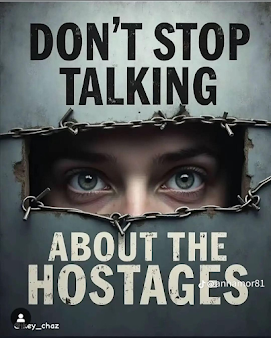

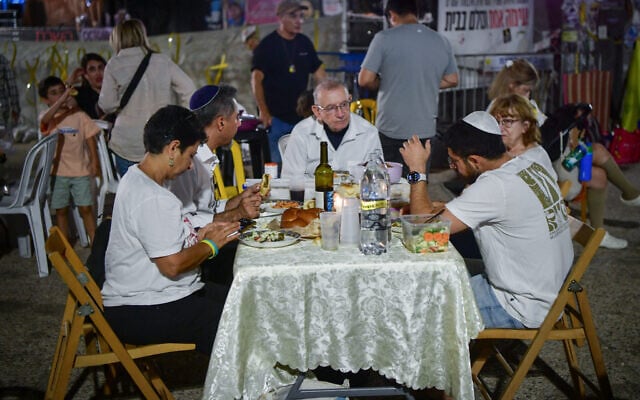



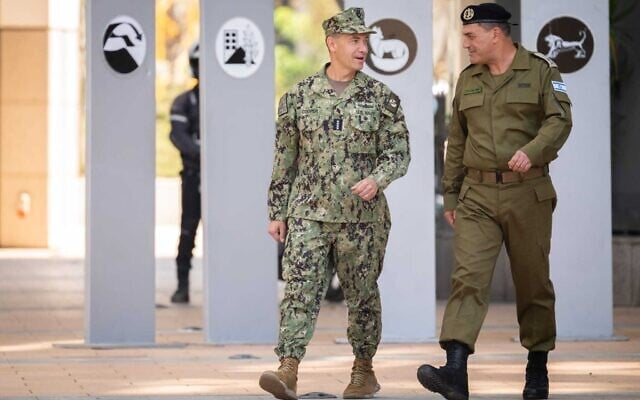
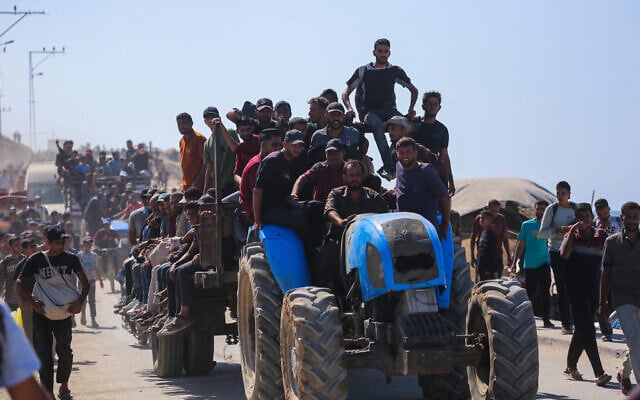
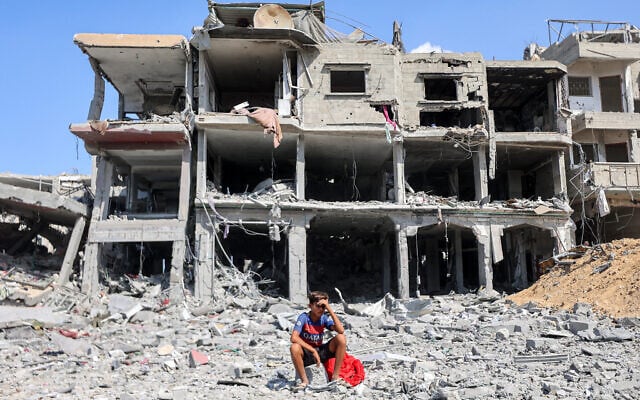
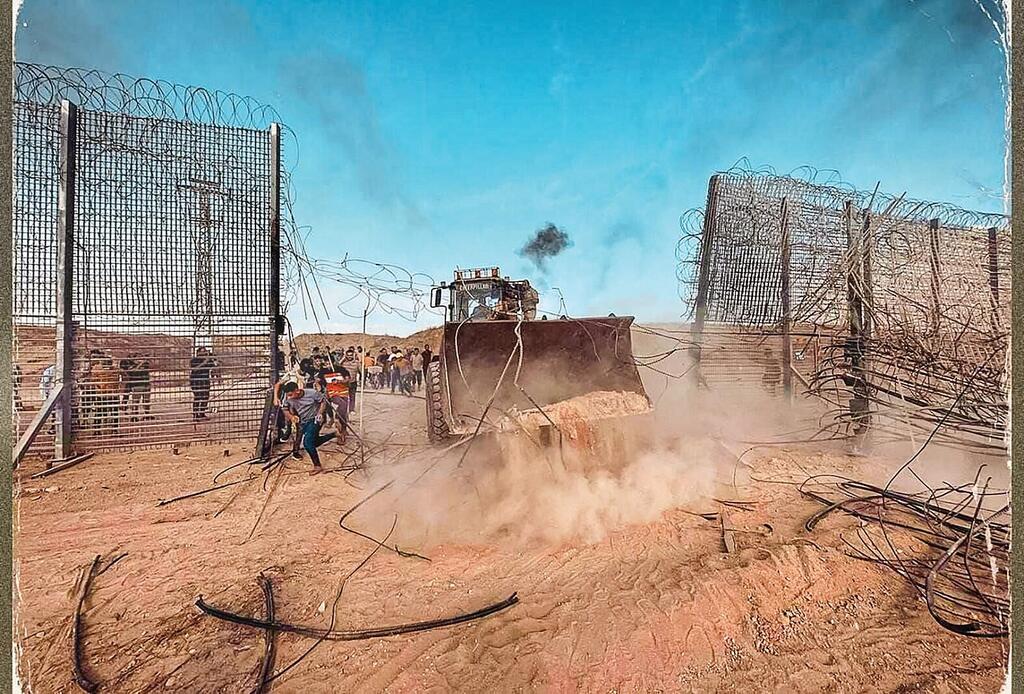
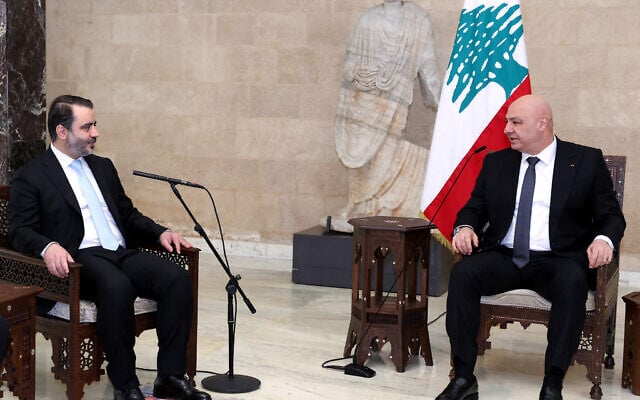
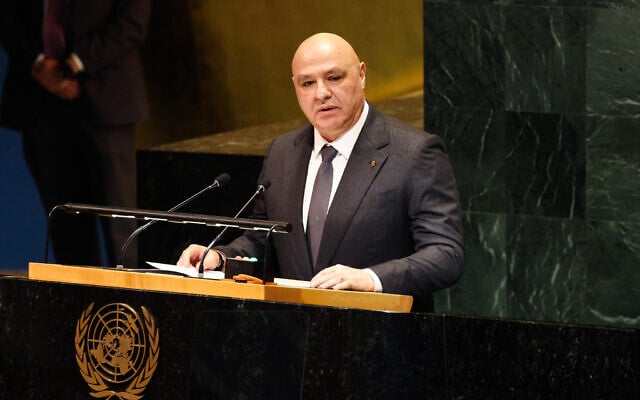
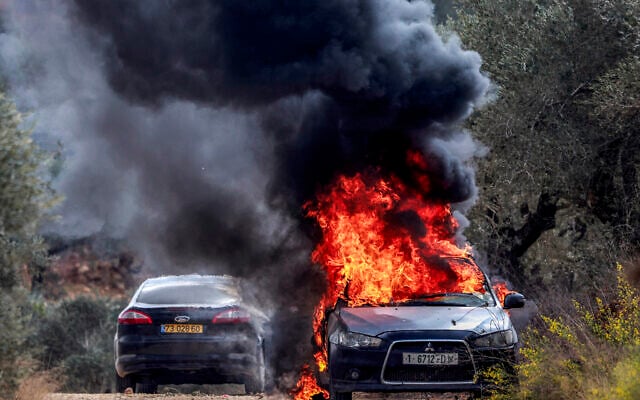


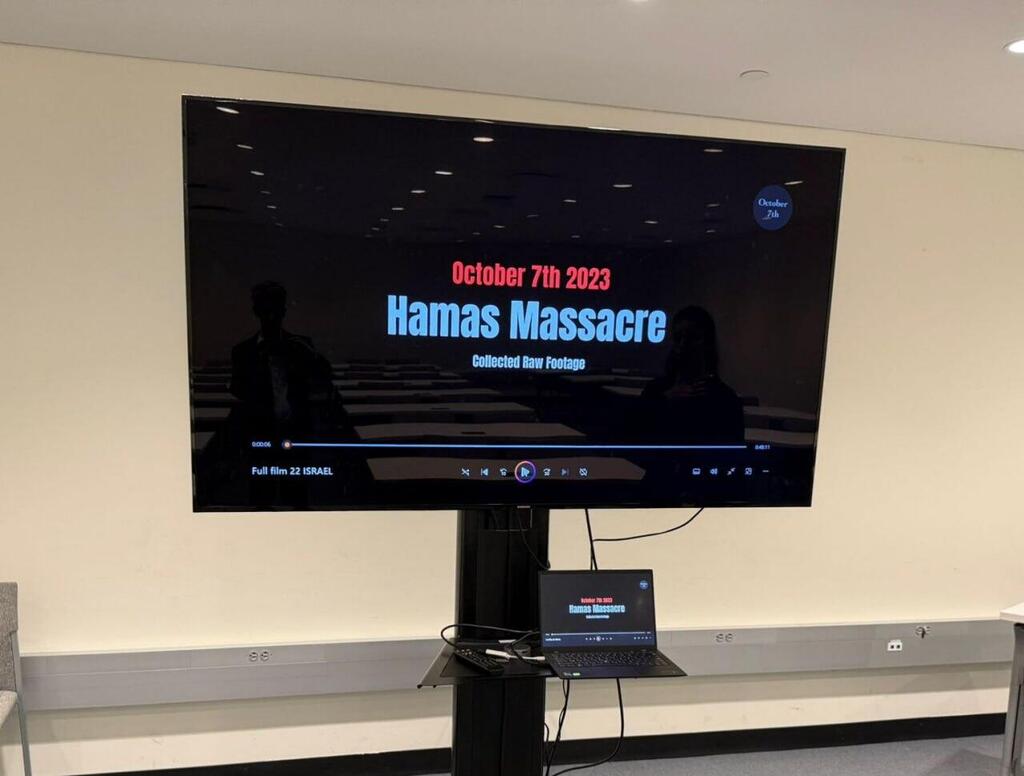







Comments
Post a Comment